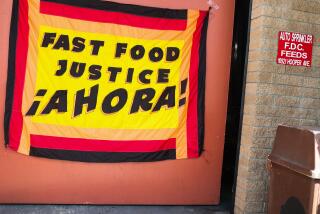How to Make Curfews Work : Carefully drawn laws will stand up, U.S. Supreme Court ruling indicates
- Share via
The U.S. Supreme Court’s recent decision to let stand a Dallas curfew law should energize law enforcement agencies in other cities trying to get a handle on escalating teen-age crime. In particular, it should encourage a promising effort in East Los Angeles.
Three Texas youths and their parents had challenged the Dallas curfew, generally requiring those under 17 to be off the streets after 11 p.m. on weekdays and after midnight on weekends. They contended that the city law “convicts the innocent . . . and broadly stifles fundamental liberties.”
The federal appeals court and now the Supreme Court have disagreed. In November, the U.S. 5th Circuit Court of Appeals held that the Dallas law is justified by the city’s “compelling interest” in reducing juvenile crime and in “promoting juvenile safety and well-being.” It cited statistics showing that murders and assaults occur most often between 11 p.m. and 1 a.m. The high court dismissed without comment the plaintiffs’ appeal from the 5th Circuit.
The Dallas law withstood legal challenge in part because it was so carefully drawn. It exempts minors accompanied by a parent or guardian, and those out after hours because of an emergency or to attend work or school. Children can also be outside after curfew if they remain in front of their home or a neighbor’s.
Similar curfew laws now exist in Los Angeles, Norwalk, Inglewood, Huntington Beach, Thousand Oaks, Walnut Park, Santa Monica and Long Beach. The Supreme Court’s decision is not binding on them but it does strongly signal that the justices will not strike down curfews as broadly unconstitutional. That’s good. But a law alone is not enough.
To be effective in keeping teen-agers from becoming the victims or the perpetrators of crime, curfews demand a major commitment of time and resources by law enforcement officials, parents and community leaders. Yet that commitment can--and sadly, does--waver in the face of more pressing police work.
In East Los Angeles, a somewhat different approach seems to be helping. A 10 p.m.-to-dawn curfew for juveniles has been on the books for many years in unincorporated parts of the county. Since January, the Sheriff’s Department has begun to ticket violators--rather than arrest and jail them, which is far more labor-intensive.
In lieu of fining them a hefty $675, the county gives parents of curfew violators a tool to intervene constructively in their kids’ lives by requiring them to attend a one-month class on peaceful ways to resolve conflict. So far, about 40 families have enrolled. The Sheriff’s Department reports that crime in the area has dipped under the new approach and that the number of minors loitering after dark has dramatically declined.
This is the kind of innovative effort that can really pay off.
More to Read
Sign up for Essential California
The most important California stories and recommendations in your inbox every morning.
You may occasionally receive promotional content from the Los Angeles Times.













